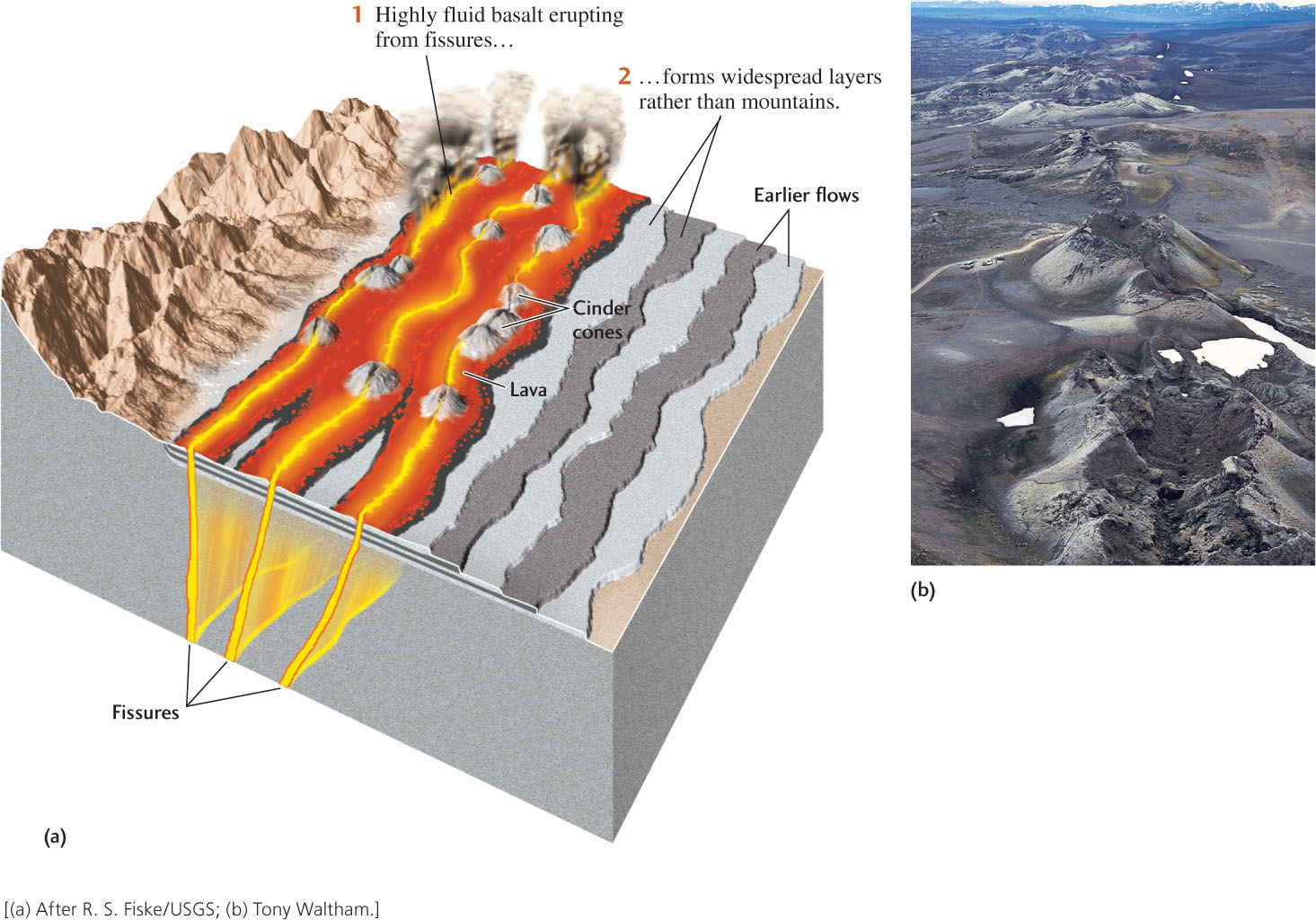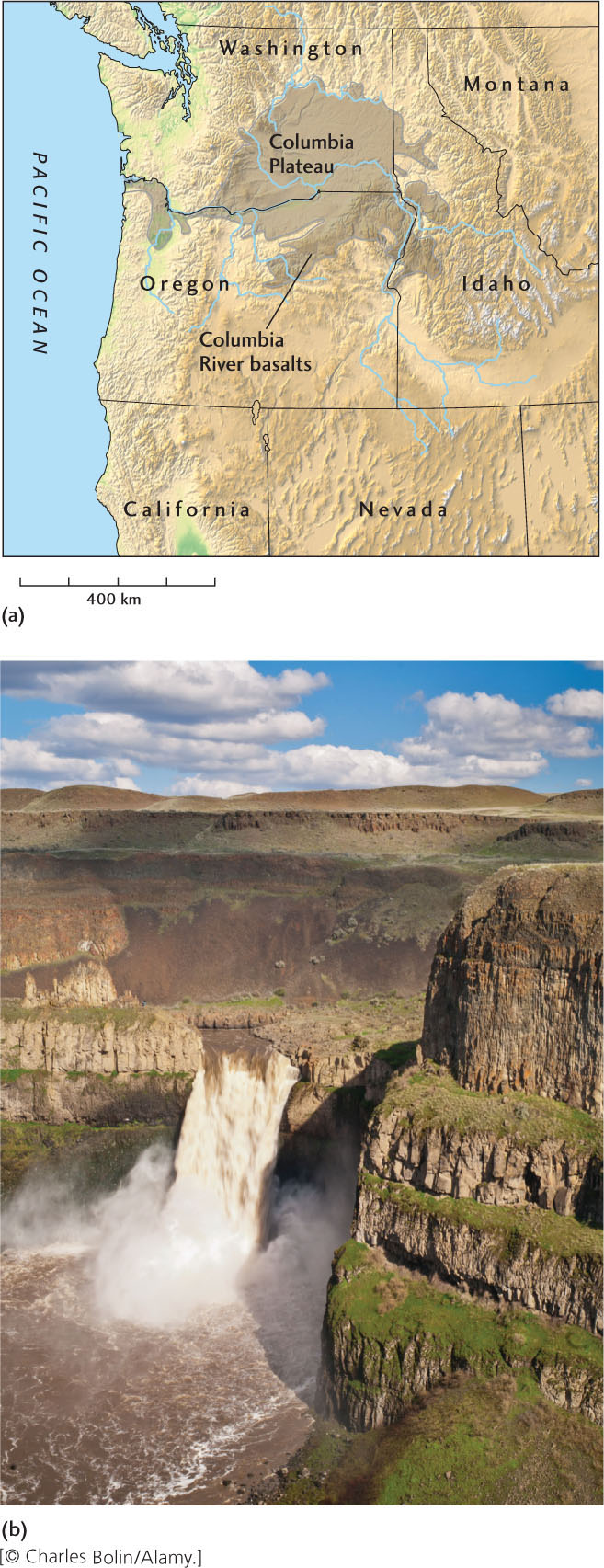Eruptive Styles and Landforms
The surface features produced by a volcano as it ejects material vary with the properties of the magma, especially its chemical composition and gas content, the type of material (lava versus pyroclasts) erupted, and the environmental conditions under which it erupts—on land or under the sea. Volcanic landforms also depend on the rate at which lava is produced and the plumbing system that gets it to the surface (Figure 12.14).

321
Central Eruptions
Central eruptions discharge lava or pyroclasts from a central vent, an opening atop a pipelike feeder channel rising from the magma chamber. The magma ascends through this channel to erupt at Earth’s surface. Central eruptions create the most familiar of all volcanic features: the volcanic mountain, shaped like a cone.
Shield Volcanoes
A lava cone is built by successive flows of lava from a central vent. If the lava is basaltic, it flows easily and spreads widely. If flows are copious and frequent, they create a broad, shield-shaped volcano 2 or more kilometers high and many tens of kilometers in circumference, with relatively gentle slopes. Mauna Loa, on the island of Hawaii, is the classic example of such a shield volcano (Figure 12.14a). Although it rises only 4 km above sea level, it is actually the world’s tallest mountain: measured from its base on the seafloor, Mauna Loa is 10 km high, taller than Mount Everest! It grew to this enormous size by the accumulation of thousands of lava flows, each only a few meters thick, over a period of about a million years. The island of Hawaii actually consists of the overlapping tops of several active shield volcanoes emerging from the ocean.
Volcanic Domes
In contrast to basaltic lavas, andesitic and rhyolitic lavas are so viscous they can barely flow. They often produce a volcanic dome, a bulbous, steep-sided mass of rock (see Figure 12.8). Domes look as though the lava has been squeezed out of a vent like toothpaste, with very little lateral spreading. Domes often plug vents, trapping gases beneath them (Figure 12.14b). Pressure can increase until an explosion occurs, blasting the dome into fragments.
Cinder Cones
When volcanic vents discharge pyroclasts, these solid fragments can build up to create cinder cones. The profile of a cinder cone is determined by the angle of repose of the fragments: the maximum angle at which the fragments will remain stable rather than sliding downhill. The larger fragments, which fall near the vent, form very steep but stable slopes. Finer particles are carried farther from the vent and form gentler slopes at the base of the cone. The classic concave-shaped volcanic cone with its central vent at the summit develops in this way (Figure 12.14c).
Stratovolcanoes
When a volcano emits lava as well as pyroclasts, alternating lava flows and beds of pyroclasts build a concave-shaped composite volcano, or stratovolcano (Figure 12.14d). Lava that solidifies in the central feeder channel and in radiating dikes strengthens the cone structure. Stratovolcanoes are common above subduction zones. Famous examples are Mount Fuji in Japan, Mount Vesuvius and Mount Etna in Italy, and Mount Rainier in Washington State. Mount St. Helens had a near-perfect stratovolcano shape until its eruption in 1980 destroyed its northern flank (see Figure 12.6).
322
323
Craters
A bowl-shaped pit, or crater, is found at the summit of most volcanic mountains, surrounding the central vent. During an eruption, the upwelling lava overflows the crater walls. When the eruption ceases, the lava that remains in the crater often sinks back into the vent and solidifies, and the crater may become partly filled by rock fragments that fall back into it. When the next eruption occurs, that material may be blasted out of the crater. Because a crater’s walls are steep, they may cave in or become eroded over time. In this way, a crater can grow to several times the diameter of the vent and hundreds of meters deep. The crater of Mount Etna in Sicily, for example, is currently 300 m in diameter.
Calderas
When great volumes of magma are discharged rapidly from a large magma chamber, the chamber can no longer support its roof. In such cases, the overlying volcanic structure can collapse catastrophically, leaving a large, steep-walled, basin-shaped depression much larger than a crater, called a caldera (Figure 12.14e). The development of the caldera that forms Crater Lake in Oregon is shown in Figure 12.15. Calderas can be impressive features, ranging in diameter from a few kilometers to 50 km or more. Owing to their size and high-volume eruptions, large caldera systems are sometimes called “supervolcanoes”. The Yellowstone supervolcano, which is the largest active volcano in the United States, has a caldera with an area greater than Rhode Island.

After some hundreds of thousands of years, enough fresh magma may reenter the collapsed magma chamber to reinflate it, forcing the caldera floor to dome upward again and creating a resurgent caldera. The cycle of eruption, collapse, and resurgence may occur repeatedly over geologic time. Three times over the last 2 million years, the Yellowstone supervolcano has erupted catastrophically, in each instance ejecting hundreds or thousands of times more material than the 1980 Mount St. Helens eruption and depositing ash over much of what is now the western United States. Other resurgent calderas are Valles Caldera in New Mexico and Long Valley Caldera in California, which last erupted about 1.2 million and 760,000 years ago, respectively.
Diatremes
When magma from Earth’s deep interior escapes explosively, the vent and the feeder channel below it are often left filled with volcanic breccia as the eruption wanes. The resulting structure is called a diatreme. Shiprock, a formation that towers over the surrounding plain in New Mexico, is a diatreme exposed by erosion of the sedimentary rocks through which it erupted. To transcontinental air travelers, Shiprock looks like a gigantic black skyscraper in the red desert (Figure 12.16).

324
The eruptive mechanism that produces diatremes has been pieced together from the geologic record. The kinds of minerals and rocks found in some diatremes could have formed only at great depths—100 km or so, well within the upper mantle. Gas-charged magmas force their way upward from these depths by fracturing the lithosphere and exploding into the atmosphere, ejecting gases and solid fragments torn from the deep crust and mantle, sometimes at supersonic speed. Such an eruption would probably look like the exhaust jet of a giant rocket upside down in the ground blowing rocks and gases into the air.
Perhaps the most exotic diatremes are kimberlite pipes, named after the fabled Kimberley diamond mines of South Africa. Kimberlite is a volcanic type of peridotite—an ultramafic rock composed primarily of olivine. Kimberlite pipes also contain a variety of mantle fragments, including diamonds that were pulled into the magma as it exploded toward the surface (see Figure 10.25). The extremely high pressures needed to squeeze carbon into the mineral diamond are reached only at depths greater than 150 km. From careful studies of diamonds and other mantle fragments found in kimberlite pipes, geologists have been able to reconstruct sections of the mantle as if they had had been able to drill down to 200 km or more. These studies provide strong support for the theory that the upper mantle is made primarily of peridotite.
325
Fissure Eruptions
The largest volcanic eruptions do not come from a central vent, but through large, nearly vertical cracks in Earth’s surface, sometimes tens of kilometers long (Figure 12.17). Such fissure eruptions are the main style of volcanism along mid-ocean ridges, where new oceanic crust is formed. A moderate-sized fissure eruption occurred in 1783 on a segment of the Mid-Atlantic Ridge that comes ashore in Iceland (Figure 12.18). A fissure 32 km long opened and, in six months, spewed out 12 km3 of basalt, enough to cover Manhattan to a height about halfway up the Empire State Building. The eruption also released more than 100 megatons of sulfur dioxide, creating a poisonous blue haze that hung over Iceland for more than a year. The resulting crop failures caused three-quarters of the island’s livestock and one-fifth of its human population to die of starvation. Sulphuric aerosols from the Laki eruption were transported by the prevailing winds across Europe, causing crop damage and respiratory illnesses in many countries.


326
Flood Basalts
Highly fluid basaltic lavas erupting from fissures on continents can spread out in sheets over flat terrain. Successive flows often pile up into immense basalt plateaus, called flood basalts, rather than forming a shield volcano as they do when the eruption is confined to a central vent. In North America, a huge eruption of flood basalts about 16 million years ago buried 160,000 km2 of preexisting topography in what is now Washington, Oregon, and Idaho to form the Columbia Plateau (Figure 12.19). Individual flows were more than 100 m thick, and some were so fluid that they traveled more than 500 km from their source. An entirely new landscape with new river valleys has since developed atop the lava that buried the old surface. Plateaus formed by flood basalts are found on every continent as well as on the seafloor.

Ash-Flow Deposits
Eruptions of pyroclasts on continents have produced extensive sheets of hard volcanic tuffs called ash-flow deposits. A succession of forests in Yellowstone National Park have been buried under such ash flows. Some of the largest pyroclastic deposits on the planet are the ash flows erupted in the mid-Cenozoic era, 45 million to 30 million years ago, through fissures in what is now the Basin and Range province of the western United States. The amount of material released during this pyroclastic flare-up was a staggering 500,000 km3—enough to cover the entire state of Nevada with a layer of rock nearly 2 km thick! Humans have never witnessed one of these spectacular events.